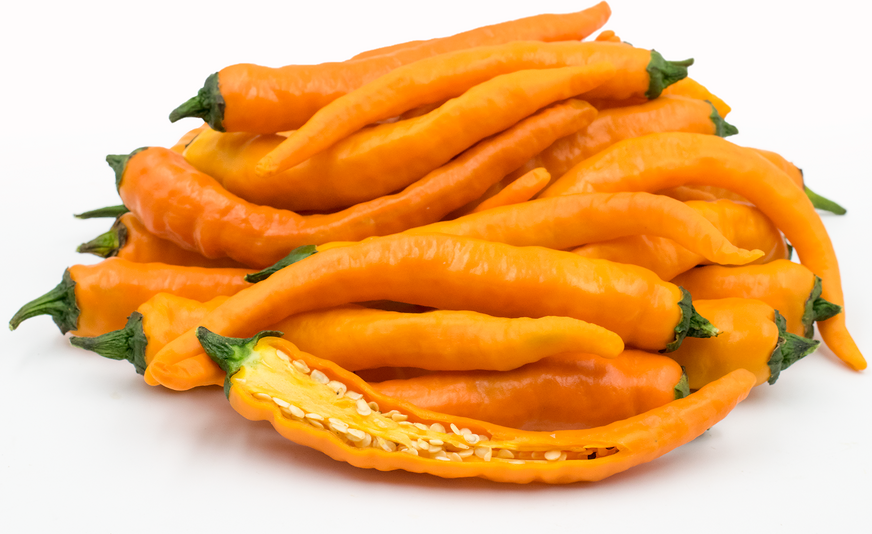


Orange Cayenne Chile Peppers
Estimated Inventory, lb : 0
Description/Taste
Orange cayenne chile peppers are elongated and slender, averaging fifteen centimeters in length and 1 to 3 centimeters in diameter, and have a straight to curved, conical shape that tapers to a pointed tip. The skin ripens from dark green to bright orange and is waxy, glossy, and smooth. Underneath the surface, the flesh is thin, pale orange, and crisp, encasing a central cavity filled with ivory-orange membranes and a few flat and round, cream-colored seeds. Orange cayenne chile peppers have a fruity, citrus-forward flavor followed by an intense, immediate heat that dissipates quickly.
Seasons/Availability
Orange cayenne chile peppers are available in the late spring through summer.
Current Facts
Orange cayenne chile peppers, botanically classified as Capsicum annuum, are mid-season, elongated pods that belong to the Solanaceae or nightshade family. The hybrid pepper is much like the red cayenne but is slightly larger with smooth, orange skin. Orange cayenne chile peppers also share a similar pungent heat to the red cayenne, averaging 35,000 SHU on the Scoville scale, but the red pepper’s spice tends to peak slightly higher in intensity depending on the growing conditions. Favored for their bright hues, large shape, and spice, Orange cayenne chile peppers are a specialty variety that is limited to home gardens and small, specialty farms. The peppers are very rare in commercial markets and are primarily available through seed catalogs in Europe and the United States.
Nutritional Value
Orange cayenne chile peppers, like their golden and red cousins, are a good source of vitamin C and vitamin A. The peppers also contain carotenoids, which are a source of antioxidants and capsaicin, which is a chemical compound that triggers the brain to feel the sensation of heat or spice and has anti-inflammatory properties.
Applications
Orange cayenne chile peppers are used similarly to red cayenne peppers and are best suited for both raw and cooked applications such as sautéing, roasting, baking, and boiling. When fresh, the peppers can be diced and added to marinades, salsas, and sauces, or they can be mixed with soft cheeses and herbs and stuffed into meats such as chicken or pork. Orange cayenne chile peppers can also be cooked in rice dishes such as paella, chopped and tossed into curries, soups, and stews, sprinkled over tacos, or stirred into casseroles. In addition to fresh applications, Orange cayenne chile peppers are popularly dried and ground into a powder for use as a spice. The dried powder can be sprinkled over eggs, noodles, cooked meats, or even used on chocolate-based desserts. Orange cayenne chile peppers pair well with broccoli, kale, tomatoes, beets, squash, herbs such as mint, cilantro, and basil, meats such as beef, pork, lamb, and poultry, onions, garlic, fennel, and potatoes. The peppers will keep 1-2 weeks when loosely stored whole and unwashed in a paper or plastic bag in the refrigerator.
Ethnic/Cultural Info
In traditional Chinese medicine, cayenne peppers are believed to promote circulation and are a warming element for the body. It is often consumed in a tea or medicinal concoction with oils and is used to stimulate digestion, open the sinuses, help reduce pain and inflammation, and to awaken the qi or the energy found within the body.
Geography/History
Cayenne chile peppers are native to South America, specifically to French Guiana, which is located on the northeast coast, and have been cultivated since ancient times. The pepper was then spread throughout South and Central America and into the Caribbean via trade and immigration, and in the 15th and 16th centuries, it was introduced to Europe and Asia via Spanish and Portuguese explorers. The exact origin of Orange cayenne chiles is unknown, but they first started appearing in seed catalogs in the United Kingdom. Today Orange cayenne chile peppers are found in limited availability through online seed catalogs in the United States and Europe for home garden use.




